Console Switch: How The Bunker Installed Its SSL 4000 E — Step by Step
Waaay back in the ‘80’s, the Fixx famously proclaimed “one thing leads to another.” And before that, the 17th Century philosopher Spinoza could have told you the same thing.
Undoubtedly, the founders of one of Brooklyn’s flagship studios, The Bunker Studio, would concur with all of the above. No sooner did they complete their 2012 move into an expansive 3,000 sq. ft. space then an inconvenient truth revealed itself to the founders, John Davis and Aaron Nevezie: They had outgrown the 26-channel Auditronics board that they had built their business around.
Swapping consoles is no easy task, but before long this heavy mission transformed from notion to necessity. Read on for a step-by-step rundown from Davis on how The Bunker recently thought through – and then executed – the complex process of locating a new board, and then switching it in:
Phase One: Outgrowing a console
For years, our Auditronics 501 console was a great center piece for our studio. It sounded awesome, and had a ton of vibe, and fit our space and workflow perfectly.
After building our new space, and putting the 501 back into service in Studio A, we had no idea if or how quickly we would outgrow it. It turned out that after about a week of tracking in a huge space with 56 mic lines and enough room to easily accomodate 20-30 musicians, we were convinced that a 26-channel vintage console with limited routing wasn’t going to cut it, no matter how cool and great sounding it was…
The discussions ranged from sidecars to custom returns sections to a big discrete desk, to an SSL.
Phase Two: Picking a desk
After all these discussions, it seemed us that the perfect solution for our room was a small frame SSL 4000. We talked to Sonic Circus (who have supplied us with gear over the years) and David (Lyons) had just purchased a few SSL and was getting ready to refurb them.
We decided that instead of running the risk of getting a cheap SSL from some closing post house, or a beater from a dormant midtown studio, we would pony up the extra budget to buy a fully refurbished desk from Sonic.
We decided on a 40-channel frame that had previously been installed in Sony Studio in Toronto. It is a late E series, and we decided on an E after researching the records made on various SSL revisions over the years… It turned out that some of our favorite records from NYC in the early ’80’s (Roxy Music’s Avalon, David Bowie’s Scary Monsters and Let’s Dance, Blondie, etc…) were made on the E series console that was apparently installed in Studio C at Power Station (now Avatar) during the time.
Phase Three: Planning the Install
We like to be prepared, so we were extremely dilligent in this regard. We mapped out a 40-input patchbay, to the DL’s, and then made a chart that corresponded to every tie line in our facility, to determine how we would integrate the desk with our wiring infrastructure. The multi pair to be cut and the DL’s were ID’d and numbered to the corresponding DL on the desk, so that as soon as we could cut our Auditronics free, we could begin pinning the DL’s in advance of the console’s arrival.
We blocked out a bunch of days between decommisioning the Auditronics and the arrival of the SSL to allow John Charette (Charette Electronics) to prepare and crimp all the DL’s in an empty room, allowing us to organize all the wires and dress them nicely.
For the physical part of getting the desk in, we made a wooden mock up of the exact footprint of the console as it would be on it’s back for transport. We tried every possible possibilty to determine the best route to take the console in, where it would have to turn, etc.
We found one problem… a corner that was a few inches too small, however it seemed that lifting one end up about 3 feet would let us clear it.
Phase Four: Load In
This part sucked.
SSLs are really really really really big and heavy. We did not split the frame, in order to reduce the chance for electronic issues at the install.
Everything went pretty smoothly right up to the point that we knew was going to be a problem. It was incredibly rough, but we got it through.
Thanks to a few really really strong friends on our crew, we were able to deal and lifted one end of a 9′, 800lb frame about 5 feet in the air and swing it around a corner. We got through with a barely scratched console leg edge, and a small tear in some tolex on the back of the meter bridge. A bummer on a console that looks factory fresh, but nearly invisible.
After that, it was smooth, and by the end of the day, install tech Steve Laisi was running a fault list on the desk. After a few days of thorough testing and dealing with some minor problems (normal for a large console commissioning) the desk was up and running. John started mixing a record immediately (while the tech bench was still set up instead of the couch) and it’s been rocking every day since.
The Auditronics is happily kicking ass in Studio B.
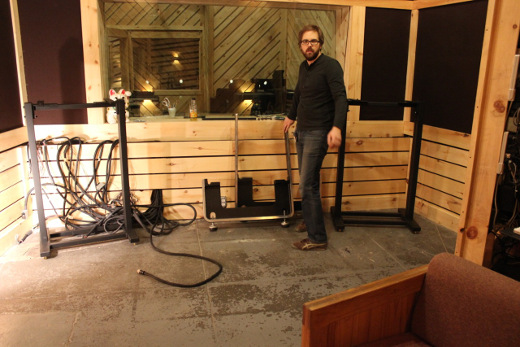
Surveying the Studio A control room one last time before moving in the board. “We were just thinking, ‘Holy sh*t, we’re moving an SSL.’ There was definitely a lot of that feeling that day,” says Nevezie.
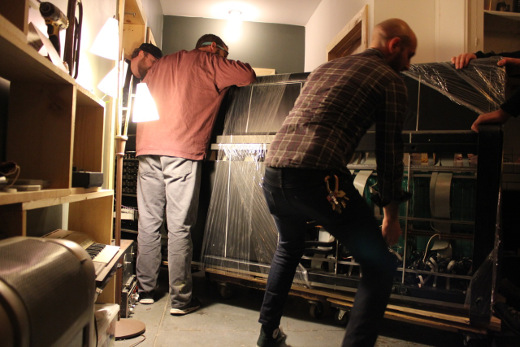
Moving a big machine, resting on its back panel, through the halls and into the control room required finesse.
— David Weiss
Visit the Bunker on SonicSearch.
Please note: When you buy products through links on this page, we may earn an affiliate commission.







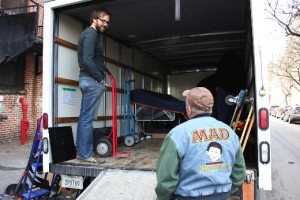
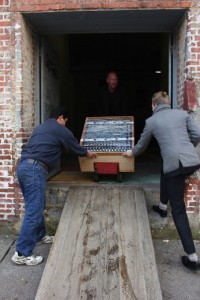
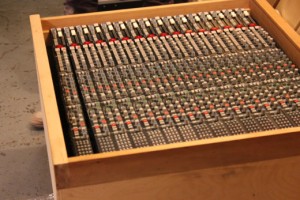
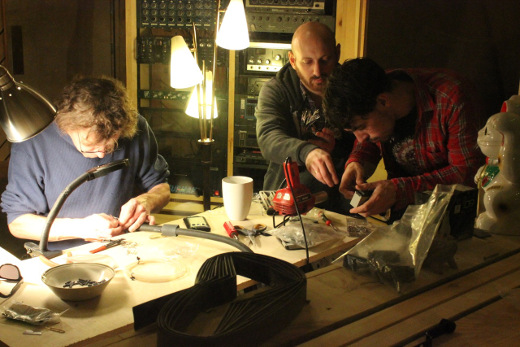
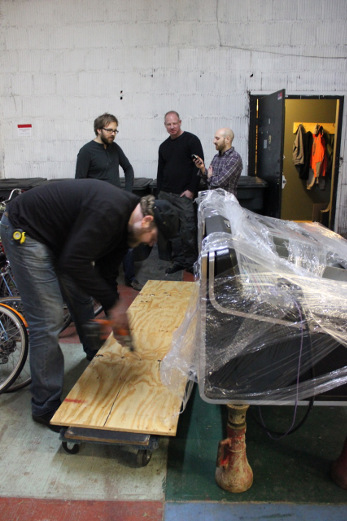
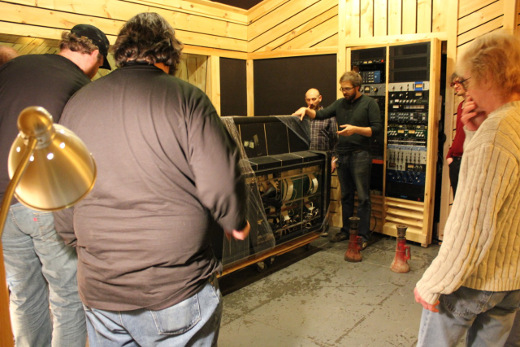
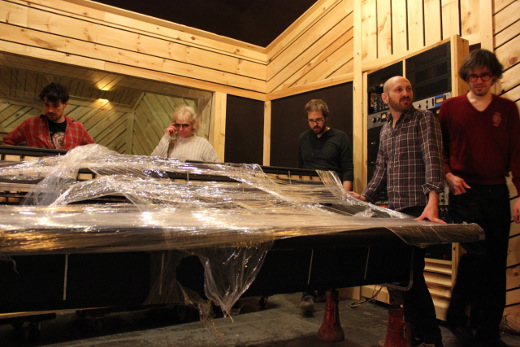
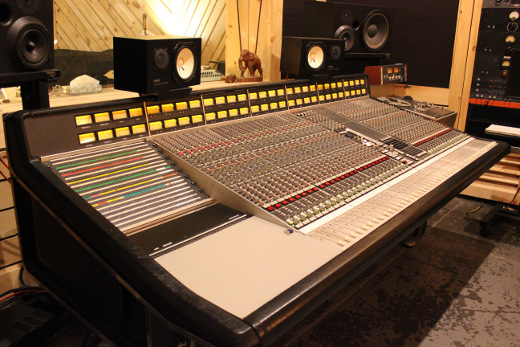
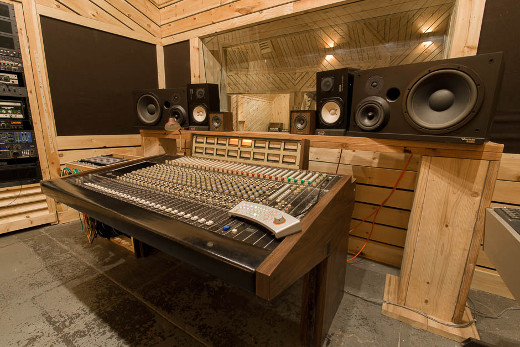
Rod Gervais
May 24, 2013 at 9:58 am (12 years ago)You guys did a great Job with this – a fantastic addition to your studio,,,,
Rod